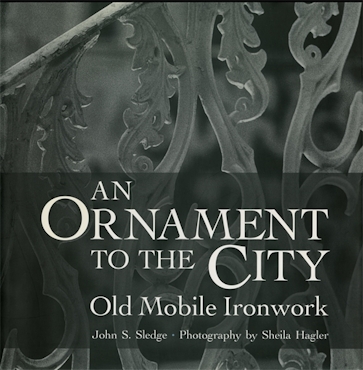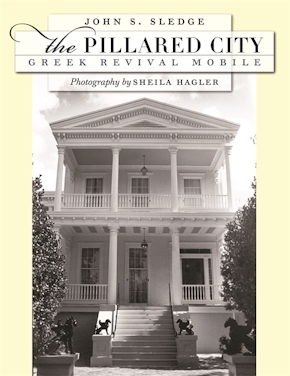An Ornament to the City
Old Mobile Ironwork
Title Details
Pages: 128
Illustrations: 80 duotone photos
Trim size: 11.000in x 11.000in
Formats
Hardcover
Pub Date: 09/15/2006
ISBN: 9-780-8203-2700-6
List Price: $40.95
An Ornament to the City
Old Mobile Ironwork
Skip to
- Description
- Reviews
The "iron lace" that graces the businesses, homes, squares, and cemeteries of Mobile, Alabama, is as vital a part of that southern port city as it is of New Orleans, Charleston, and Savannah. Until now, its story has never been fully told. In this attractive volume, John S. Sledge's rich narrative, combined with evocative historic images and Sheila Hagler's stunning contemporary photographs, eloquently conveys as never before how ornamental cast iron defines Mobile's heart and soul.
Cast iron was the wonder of the Victorian age, according to Sledge. In Mobile, the material's diverse applications were on display in hulking locomotives and boilers, flamboyant fountains, imposing fences, and endless other forms and structures. The city's ornate iron balconies, dozens of which still remain, elicited the greatest wonder, then as now. Local publications have long extolled Mobile's enchanting ironwork. Only now, however, has the subject been situated within national trends in design, industry, and consumer tastes. It is a colorful saga featuring rawboned iron founders, artisan slaves, hustling salesmen, conniving architects, willful plunderers, romantic artists, and dedicated preservationists.
Drawing on rare surviving business records and other archival sources, Sledge skillfully reconstructs how the local iron industry developed and then fiercely competed with big northern foundries. As a working preservationist, Sledge pays particular attention to how many of Mobile's most splendid ornamental iron pieces have weathered hard times, natural disasters, and misguided development to remain a delight for tourists and residents alike. Hagler's beautiful photographs provide a powerful and sometimes moody visual accompaniment to this fascinating tale.
With a storyteller's sure sense of drama, John Sledge brings to life the history of Mobile's ornamental ironwork. He writes with felicity, using contemporary sources and the backdrop of local history and the ironworking industry to enrich his architectural commentary, with rewarding results.
—Alice Bowsher, author of Alabama Architecture: Looking at Building and Place
This celebration of the ironwork that graces the city of Mobile is a fine addition to the shelf of books on 19th century cast-iron architecture in America. Well-researched and engagingly written, the book documents how Mobile, like other southern port cities, began to use iron as a building material as early as the 1820s. In Mobile, iron was most frequently employed for lacy balconies and gorgeous verandahs, where one could find a cool breeze, as well as for elegant fences. Besides "iron lace," one could also find cast iron fountains, park benches, and statuary. A fine ironfront building, which stands today, was erected in 1860. As was the case in most other American cities, iron architecture fell out of favor after the 1880s and was often sold off as scrap in the 20th century. Urban renewal programs following World War II cost Mobile even more of its iron lace heritage. However, preservation efforts took hold in the 1970s and Mobile was able to preserve a portion of its ironwork and to restore it lovingly. Historic preservationists and especially fanciers of cast iron will welcome this appreciation of the ironwork of Mobile. The careful account by historian and preservationist John Sledge, richly illustrated, with many contemporary photographs by Sheila Hagler, reminds us of what was lost—but also what was saved.
—Carol Gayle, author of Cast-Iron Architecture in America: The Significance of James Bogardus
Riding a crest of cotton prosperity, nineteenth-century Mobile produced one of the South’s most elegant urban landscapes. And now we have a full-blown study of one of its key defining features: the decorative ironwork that adorned the city’s squares, sidewalks, cemeteries, and literally scores of buildings. Unlike the more famous ironwork of New Orleans’s crowded French Quarter, Mobile’s balconies and verandas of 'iron lace' spread well beyond the core of the city, bejewelling whole tree-shaded blocks of stately homes. Most of the ironwork is gone today. But a lot also remains. And in graceful prose, based on fresh research and accompanied by old images as well as lush new photographs, John Sledge recounts the entire saga of Mobile’s ironwork. The saga includes some surprising twists and turns that will both delight and inform the reader. Sledge’s special gift for telling the human side of the story—from the poignant 'Sambo' statue of Bienville Square to the struggles of ironwork salesman Daniel Geary—further enriches this splendid contribution to our understanding of how an evolving technology merged with aesthetic sensibility on the southern urban scene.
—Robert Gamble, Chief Architectural Historian, Alabama Historical Commission
Sledge has fashioned a tale of love and loss, woven together with the touch of a true cultural historian. Supported by extensive research, the book is factually informative, creating the first ever narrative history of Mobile's ornamental ironwork and by extension an important text for the history of American nineteenth century decorative arts. As an historical preservationist, Sledge is well positioned to recount the very fascinating final chapter of the losses, slow recognition, and eventual true appreciation of the glories of Mobile's proud tradition of ornamental ironwork.
—First Draft
Handsome, full of lush, velvety pictures . . . offers a text of anecdote and history, all given in a graceful and pleasing style, with entertainment for those who choose to nibble at the text for fun, and more profound lessons for those who wish a serious study with context and history . . . Sledge and Hagler accomplished their goal splendidly.
—Mobile Press-Register
Sledge crafts his story from personal accounts, pictures, and correspondence. As such, it turns into a tale about the people and times throughout Mobile's long history.
—Southern Living
Sledge is quite a word smith whose sentences are, at times, as ornate as the ironworks lacy designs. . . . This book is sure to whet the appetite of those interested in historic downtown Mobile. It is recommended for those who appreciate photography, history and architecture.
—Mississippi Press
I can guarantee those paging through An Ornament to the City will be impressed. . . . Fortunately, there is still a good deal of ironwork surviving, and if it is up to historical preservationists like John Sledge, no more will be lost.
—Tuscaloosa News



